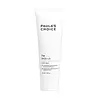What's inside
What's inside
 Key Ingredients
Key Ingredients

 Benefits
Benefits

 Concerns
Concerns

 Ingredients Side-by-side
Ingredients Side-by-side

Water
Skin ConditioningPumice
AbrasiveGlycerin
HumectantCaprylic/Capric Triglyceride
MaskingDimethicone
EmollientEthylhexyl Palmitate
EmollientCetyl Alcohol
EmollientStearyl Alcohol
EmollientTitanium Dioxide
Cosmetic ColorantCetearyl Alcohol
EmollientCeteareth-20
CleansingGlyceryl Stearate
EmollientPEG-100 Stearate
Saccharum Officinarum Extract
MoisturisingCitrus Medica Limonum Fruit Extract
Skin ConditioningPyrus Malus Fruit Extract
Skin ConditioningCamellia Sinensis Leaf Extract
AntimicrobialSodium Acrylate/Sodium Acryloyldimethyl Taurate Copolymer
Emulsion StabilisingIsohexadecane
EmollientPolysorbate 80
EmulsifyingSodium Benzoate
MaskingGluconolactone
Skin ConditioningXanthan Gum
EmulsifyingSodium Magnesium Silicate
Tetrasodium EDTA
Parfum
MaskingBlue 1 Lake
Cosmetic ColorantWater, Pumice, Glycerin, Caprylic/Capric Triglyceride, Dimethicone, Ethylhexyl Palmitate, Cetyl Alcohol, Stearyl Alcohol, Titanium Dioxide, Cetearyl Alcohol, Ceteareth-20, Glyceryl Stearate, PEG-100 Stearate, Saccharum Officinarum Extract, Citrus Medica Limonum Fruit Extract, Pyrus Malus Fruit Extract, Camellia Sinensis Leaf Extract, Sodium Acrylate/Sodium Acryloyldimethyl Taurate Copolymer, Isohexadecane, Polysorbate 80, Sodium Benzoate, Gluconolactone, Xanthan Gum, Sodium Magnesium Silicate, Tetrasodium EDTA, Parfum, Blue 1 Lake
Water
Skin ConditioningJojoba Esters
EmollientCaprylic/Capric Triglyceride
MaskingGlycerin
HumectantPEG-20 Methyl Glucose Sesquistearate
EmulsifyingMethyl Glucose Sesquistearate
EmollientTocopheryl Acetate
AntioxidantDecyl Glucoside
CleansingPPG-20 Methyl Glucose Ether
Skin ConditioningGlyceryl Stearate
EmollientStearyl Alcohol
EmollientPolyacrylamide
Sapindus Mukorossi Peel Extract
Skin ConditioningChamomilla Recutita Flower Extract
MaskingCamellia Oleifera Leaf Extract
AstringentXanthan Gum
EmulsifyingC13-14 Isoparaffin
EmollientCaprylyl Glycol
EmollientCitric Acid
BufferingDisodium EDTA
Laureth-7
EmulsifyingPhenoxyethanol
PreservativeEthylhexylglycerin
Skin ConditioningWater, Jojoba Esters, Caprylic/Capric Triglyceride, Glycerin, PEG-20 Methyl Glucose Sesquistearate, Methyl Glucose Sesquistearate, Tocopheryl Acetate, Decyl Glucoside, PPG-20 Methyl Glucose Ether, Glyceryl Stearate, Stearyl Alcohol, Polyacrylamide, Sapindus Mukorossi Peel Extract, Chamomilla Recutita Flower Extract, Camellia Oleifera Leaf Extract, Xanthan Gum, C13-14 Isoparaffin, Caprylyl Glycol, Citric Acid, Disodium EDTA, Laureth-7, Phenoxyethanol, Ethylhexylglycerin
 Reviews
Reviews

Ingredients Explained
These ingredients are found in both products.
Ingredients higher up in an ingredient list are typically present in a larger amount.
This ingredient is an emollient, solvent, and texture enhancer. It is considered a skin-softener by helping the skin prevent moisture loss.
It helps thicken a product's formula and makes it easier to spread by dissolving clumping compounds.
Caprylic Triglyceride is made by combining glycerin with coconut oil, forming a clear liquid.
While there is an assumption Caprylic Triglyceride can clog pores due to it being derived from coconut oil, there is no research supporting this.
Learn more about Caprylic/Capric TriglycerideGlycerin is already naturally found in your skin. It helps moisturize and protect your skin.
A study from 2016 found glycerin to be more effective as a humectant than AHAs and hyaluronic acid.
As a humectant, it helps the skin stay hydrated by pulling moisture to your skin. The low molecular weight of glycerin allows it to pull moisture into the deeper layers of your skin.
Hydrated skin improves your skin barrier; Your skin barrier helps protect against irritants and bacteria.
Glycerin has also been found to have antimicrobial and antiviral properties. Due to these properties, glycerin is often used in wound and burn treatments.
In cosmetics, glycerin is usually derived from plants such as soybean or palm. However, it can also be sourced from animals, such as tallow or animal fat.
This ingredient is organic, colorless, odorless, and non-toxic.
Glycerin is the name for this ingredient in American English. British English uses Glycerol/Glycerine.
Learn more about GlycerinGlyceryl Stearate is a mix of glycerin and stearic acid.
It is used to stabilize the mixing of water and oil ingredients. By preventing these ingredients from separating, it can help elongate shelf life. It can also help thicken the product's texture.
As an emollient, it helps soften skin and supports barrier-replenishing ingredients.
In cosmetics, Glyceryl Stearate is often made from vegetable oils or synthetically produced.
This ingredient may not be fungal-acne safe
Fun fact: The human body also creates Glyceryl Stearate naturally.
Learn more about Glyceryl StearateStearyl Alcohol is a type of fatty alcohol from stearic acid. It is a white, waxy compound used to emulsify ingredients.
Fatty Alcohols are most often used as an emollient or to thicken a product. Emollients help soothe and hydrate the skin by trapping moisture.
They are usually derived from natural fats and oils and therefore do not have the same drying or irritating effect as solvent alcohols. FDA allows products labeled "alcohol-free" to have fatty alcohols.
Learn more about Stearyl AlcoholWater. It's the most common cosmetic ingredient of all. You'll usually see it at the top of ingredient lists, meaning that it makes up the largest part of the product.
So why is it so popular? Water most often acts as a solvent - this means that it helps dissolve other ingredients into the formulation.
You'll also recognize water as that liquid we all need to stay alive. If you see this, drink a glass of water. Stay hydrated!
Learn more about WaterXanthan gum is used as a stabilizer and thickener within cosmetic products. It helps give products a sticky, thick feeling - preventing them from being too runny.
On the technical side of things, xanthan gum is a polysaccharide - a combination consisting of multiple sugar molecules bonded together.
Xanthan gum is a pretty common and great ingredient. It is a natural, non-toxic, non-irritating ingredient that is also commonly used in food products.
Learn more about Xanthan Gum